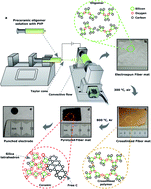Self-supporting carbon-rich SiOC ceramic electrodes for lithium-ion batteries and aqueous supercapacitors†‡
Abstract
Fabrication of precursor-derived ceramic fibers as electrodes for energy storage applications remains largely unexplored. Within this work, three little known polymer-derived ceramic (PDC)-based fibers are being studied systemically as potential high-capacity electrode materials for electrochemical energy devices. We report fabrication of precursor-derived SiOC fibermats via one-step spinning from various compositions of siloxane oligomers followed by stabilization and pyrolysis at 800 °C. Electron microscopy, Raman, FTIR, XPS, and NMR spectroscopies reveal transformation from polymer to ceramic stages of the various SiOC ceramic fibers. The ceramic samples are a few microns in diameter with a free carbon phase embedded in the amorphous Si–O–C structure. The free carbon phase improves the electronic conductivity and provides major sites for ion storage, whereas the Si–O–C structure contributes to high efficiency. The self-standing electrodes in lithium-ion battery half-cells deliver a charge capacity of 866 mA h gelectrode−1 with a high initial coulombic efficiency of 72%. As supercapacitor electrode, SiOC fibers maintain 100% capacitance over 5000 cycles at a current density of 3 A g−1.



 Please wait while we load your content...
Please wait while we load your content...